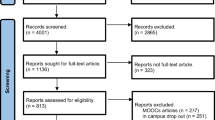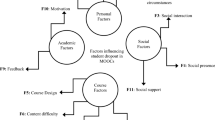Abstract
Although online learning is expanding in availability and popularity, the high dropout rates remain a challenging problem. In this paper, we reviewed the existing empirical studies on online course dropouts in post-secondary education that were published during the last 10 years. We identified 69 factors that influence students’ decisions to dropout and classified them into three main categories: (a) Student factors, (b) Course/Program factors, and (c) Environmental factors. We then examined the strategies proposed to overcome these dropout factors: (a) understanding each student’s challenges and potential, (b) providing quality course activities and well-structured supports, and (c) handling environmental issues and emotional challenges. Finally, we discussed issues regarding dropout factors and strategies for addressing these factors and offered recommendations for future research.



Similar content being viewed by others
References
*These references make up the 35 past empirical studies that we reviewed
Allen, I. E., & Seaman, J. (2008). Staying the course: Online education in the United States. Needham, MA: Sloan Consortium.
*Bocchi, J., Eastman, J. K., & Swift, C. O. (2004). Retaining the online learner: Profile of students in an online MBA program and implications for teaching them. Journal of Education for Business, 79(4), 245–253.
*Carr, S. (2000). As distance education comes of age, the challenge is keeping the students. Chronicle of Higher Education, 46, 39–42.
*Castles, J. (2004). Persistence and the adult learner: Factors affecting persistence in Open University students. Active Learning in Higher Education, 5(2), 166–179.
*Cheung, L. L. W., & Kan, A. C. N. (2002). Evaluation of factors related to student performance in a distance-learning business communication course. Journal of Education for Business, 77(5), 257.
*Chyung, S. Y. (2001). Systematic and systemic approaches to reducing attrition rates in online higher education. American Journal of Distance Education, 15(3), 36–49.
*Clay, M. N., Rowland, S., & Packard, A. (2009). Improving undergraduate online retention through gated advisement and redundant communication. Journal of College Student Retention: Research, Theory and Practice, 10(1), 93–102.
Creswell, J. W. (2008). Research design: Qualitative, quantitative, and mixed methods approaches (3rd ed.). Upper Saddle River, New Jersey: Pearson Prentice Hall.
Diaz, D. P. (2002). Online drop rate revisited. The technology source, May/June. Retrieved from http://technologysource.org/issue/2002-05/.
*Drouin, M. A. (2008). The relationship between students’ perceived sense of community and satisfaction, achievement, and retention in an online course. Quarterly Review of Distance Education, 9(3), 267–284.
*Dupin-Bryant, P. (2004). Pre-entry variables related to retention in online distance education. American Journal of Distance Education, 18(4), 199–206.
Finnegan, C., Morris, L. V., & Lee, K. (2009). Differences by course discipline on student behavior, persistence, and achievement in online courses of undergraduate general education. Journal of College Student Retention: Research, Theory and Practice, 10(1), 39–54.
*Frydenberg, J. (2007). Persistence in university continuing education online classes. International Review of Research in Open and Distance Learning, 8(3), 1–15.
Harasim, L. (2000). Shift happens: Online education as a new paradigm in learning. The Internet and Higher Education, 3(1–2), 41–61.
*Holder, B. (2007). An investigation of hope, academics, environment, and motivation as predictors of persistence in higher education online programs. Internet and Higher Education, 10(4), 245–260.
Greene, J. C., & Caracelli, V. J. (1997). Defining and describing the paradigm issue in mixed-method evaluation. In J. C. Greene & V. J. Caracelli (Eds.), Advances in mixed-method evaluation: The challenges and benefits of integrating diverse paradigms (pp. 5–17). San Francisco, CA: Jossey-Bass.
*Ivankova, N. V., & Stick, S. L. (2007). Students’ persistence in a distributed doctoral program in educational leadership in higher education: A mixed methods study. Research in Higher Education, 48(1), 93–135.
Kember, D. (1995). Open learning courses for adults: A model of student progress. Englewood Cliffs, NJ: Educational Technology Publications.
*Kemp, W. C. (2002). Persistence of adult learners in distance education. American Journal of Distance Education, 16(2), 65.
*Levy, Y. (2007). Comparing dropouts and persistence in e-learning courses. Computers and Education, 48(2), 185–204.
Lincoln, Y. S., & Guba, E. G. (1985). Naturalistic inquiry. Beverly Hills, GA: Sage Publications.
*Liu, S. Y., Gomez, J., & Cherng-Jyh, Y. (2009). Community college online course retention and final grade: Predictability of social presence. Journal of Interactive Online Learning, 8(2), 165–182.
*Moore, K., Bartkovich, J., Fetzner, M., & Ison, S. (2003). Success in cyberspace: Student retention in online courses. Journal of Applied Research in the Community College, 10(2), 12.
Moore, M., & Kearsley, G. (1996). Distance education: A system view. Belmont, CA: Wadsworth.
*Morgan, C. K., & Tam, M. (1999). Unravelling the complexities of distance education student attrition. Distance Education, 20(1), 96–108.
*Morris, L. V., Finnegan, C., & Wu, S. (2005a). Tracking student behavior, persistence, and achievement in online courses. The Internet and Higher Education, 8(3), 221–231.
*Morris, L. V., Wu, S., & Finnegan, C. L. (2005b). Predicting retention in online general education courses. American Journal of Distance Education, 19(1), 23–36.
*Muilenburg, L. Y., & Berge, Z. L. (2001). Barriers to distance education: A factor analytic study. The American Journal of Distance Education, 11(2), 39–54.
*Müller, T. (2008). Persistence of women in online degree-completion programs. International Review of Research in Open and Distance Learning, 9(2), 1–18.
*Osborn, V. (2001). Identifying at-risk students in videoconferencing and web-based distance education. American Journal of Distance Education, 15(1), 41–54.
*Packham, G., Jones, P., Miller, C., & Thomas, B. (2004). E-learning and retention: Key factors influencing student withdrawal. Education Training, 46(6/7), 335–342.
*Parker, A. (1999). A study of variables that predict dropout from distance education. International Journal of Educational Technology, 1(2), 1–10.
*Parker, A. (2003). Identifying predictors of academic persistence in distance education. United States Distance Learning Association Journal, 17(1), 55–61.
*Perry, B., Boman, J., Care, W. D., Edwards, M., & Park, C. (2008). Why do students withdraw from online graduate nursing and health studies education? Journal of Educators Online, 5(1), 1–17.
*Pierrakeas, C., Xenos, M., Panagiotakopoulos, C., & Vergidis, D. (2004). A comparative study of dropout rates and causes for two different distance education courses. International Review of Research in Open and Distance Learning, 5(2), 1–13.
*Pigliapoco, E., & Bogliolo, A. (2008). The effects of psychological sense of community in online and face-to-face academic courses. International Journal of Emerging Technologies in Learning, 3 (4), 60–69.
*Poellhuber, B., Chomienne, M., & Karsenti, T. (2008). The effect of peer collaboration and collaborative learning on self-efficacy and persistence in a learner-paced continuous intake model. Journal of Distance Education, 22(3), 41–62.
*Rolfe, C. J. (2007). Getting the bugs out of the distance learning experience. College Quarterly, 10(3), 1–35.
Rotter, J. B. (1966). Generalized expectancies for internal versus external control of reinforcement. Washington, DC: American Psychological Association.
*Rovai, A. P., & Wighting, M. J. (2005). Feelings of alienation and community among higher education students in a virtual classroom. The Internet and Higher Education, 8(2), 97–110.
*Shin, N., & Kim, J. (1999). An exploration of learner progress and drop-out in Korea National Open University. Distance Education, 20(1), 81–95.
*Tello, S. F. (2007). An analysis of student persistence in online education. International Journal of Information and Communication Technology Education, 3(3), 47–62.
Tinto, V. (1975). Dropout from higher education: A theoretical synthesis of recent research. Review of Educational Research, 45(1), 89–125.
*Willging, P. A., & Johnson, S. D. (2004). Factors that influence students’ decision to dropout of online courses. Journal of Asynchronous Learning Networks, 8(4), 105–118.
*Woodley, A., De Lange, P., & Tanewski, G. (2001). Student progress in distance education: Kember’s model re-visited. Open Learning, 16(2), 113–131.
*Xenos, M., Pierrakeas, C., & Pintelas, P. (2002). A survey on student dropout rates and dropout causes concerning the students in the Course of Informatics of the Hellenic Open University. Computers and Education, 39(4), 361.
Author information
Authors and Affiliations
Corresponding author
Rights and permissions
About this article
Cite this article
Lee, Y., Choi, J. A review of online course dropout research: implications for practice and future research. Education Tech Research Dev 59, 593–618 (2011). https://doi.org/10.1007/s11423-010-9177-y
Published:
Issue Date:
DOI: https://doi.org/10.1007/s11423-010-9177-y




